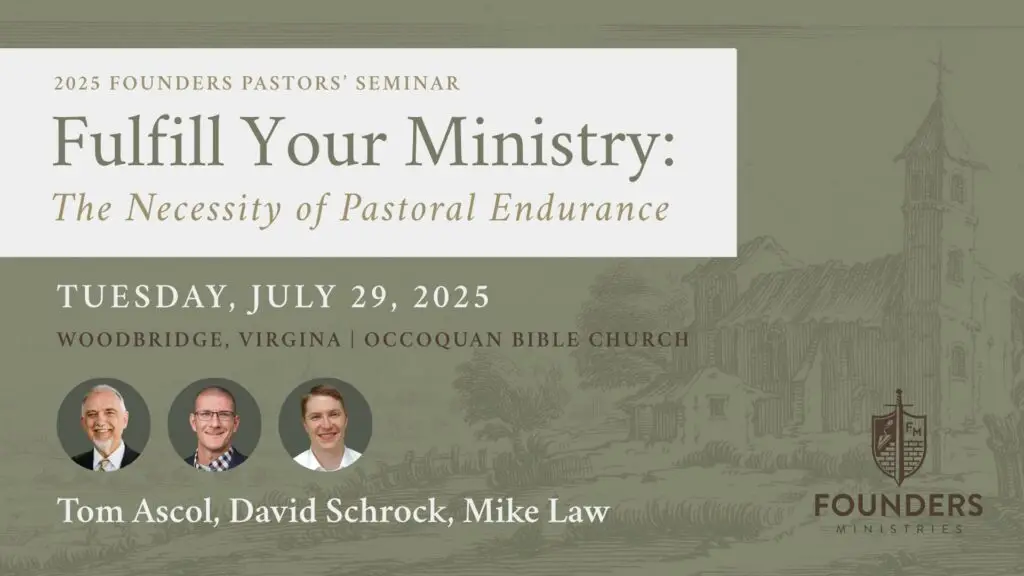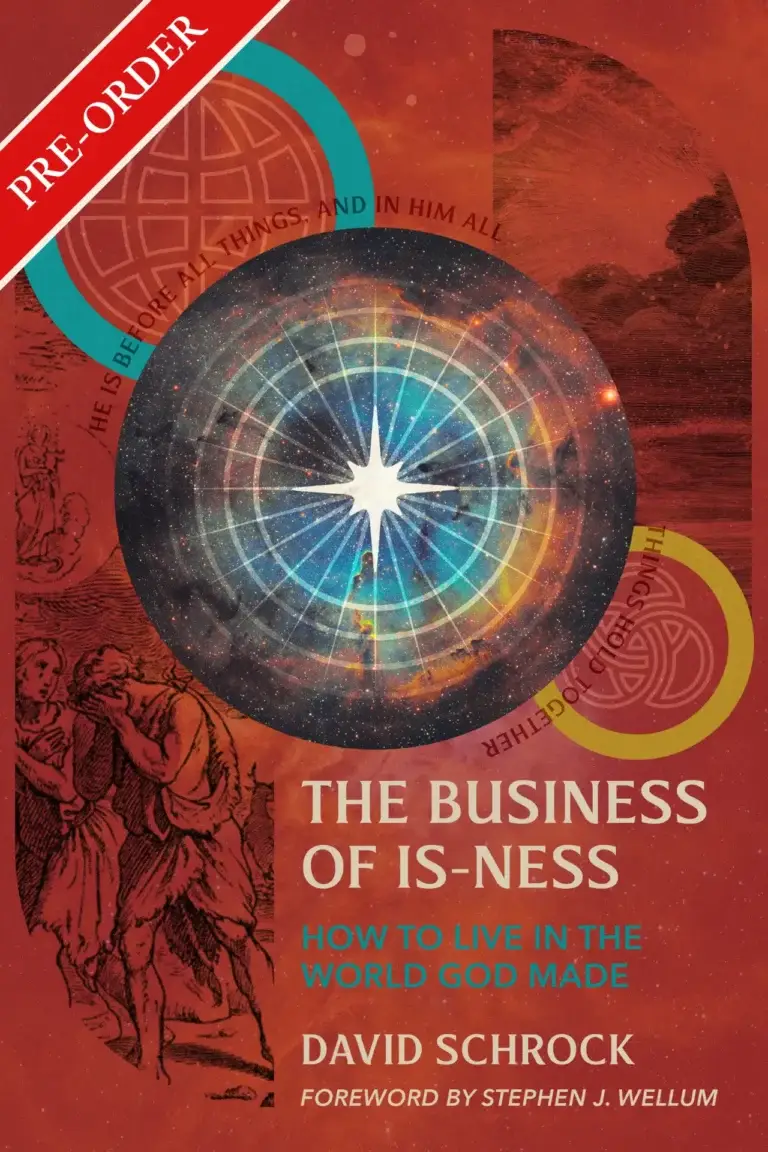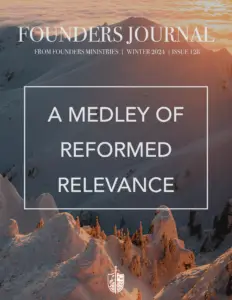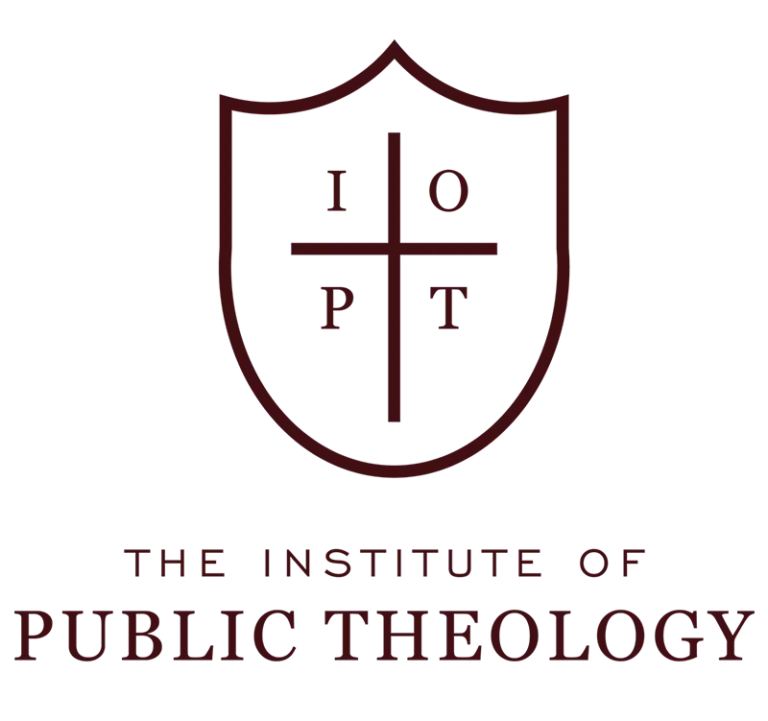As Christian, the allegorical pilgrim, marched into the river, chest-deep and deeper, he rejoiced with a song: “O grave, where is thy victory? O death, where is thy sting?” This comes from the second part of the Pilgrim’s Progress, where John Bunyan (1628–1688) writes of the believer’s approach to death. When the pilgrim ends the song, he hears at last the sounding of trumpets; the long journey is complete and he finally enters the Celestial City.[1] Herein is a Baptist interpretation of this hope-filled verse—no matter if this story is an allegory, it stands in a tradition that sees Christians singing triumphantly at death, believing they will meet their Lord immediately thereafter.
There is yet very little research in terms of collecting a Baptistic tradition of interpretation in biblical studies verse-by-verse, let alone book-by-book. However, through this very small survey, I observe several Baptist sources and deduce the interpretation and use of 1 Corinthians 15:55. The individual authors may elucidate different sides of the gemstone, but Particular Baptist tradition holds together a cohesive interpretation. Herein we examine how this verse was understood in Baptist life through 200 years; for what purpose was the verse used and what key doctrines were advanced through its interpretation? While much of the thought and application from these verses can be found in other reformed traditions, the purpose here is to isolate and engage with an unambiguously Baptist tradition. The below sources are all from Particular Baptists beginning with the first published work in 1676 and ending with a work from 1883; these works are gathered from theological treatises, sermons, letters, and personal journals. There are numerous other sources, but the following suffice in surveying a tradition of use and interpretation of this verse among Baptists. The survey concludes that Particular Baptist tradition utilizes 1 Corinthians 15:55 to contend for the providence of God in death, a secured new life to come, a song to be sung in sanctification as well as glorification, and a song applied as a salve to extinguish sin in the present life.
A Baptist Tradition in Death
The most obvious aspect of 1 Corinthians 15:55 is the use in a Christian approach to death. From 1677 onward, the surrounding verses provided for the Baptist doctrine both of the state of man after death and of the second coming. The Second London Confession of Faith (1689) provides explicit reference to 1 Corinthians 15.[2] There is one death for the saints; the soul departs from the body, but does not sleep, rather it inhabits a paradise where it is made holy forevermore. There, the soul awaits the second coming of Christ, when it shall return to a resurrected body, the same yet now glorified and immortal. The soul and body will reunite finally and forever. Samuel Waldron notes that this paradise, for the elect of God where the soul awaits the body, is not heaven. However, like heaven, it is a place with space and time—God alone is the only being not constrained by his own created order.[3] This confessional doctrine is not merely for head knowledge but for the purpose of ministering to the saints. Those who followed after this Baptistic confession of faith did not deviate from the position found here, but expounded upon this doctrine for application to themselves nearing death, and for their churches—for encouragement, fortitude, and worship. If the Lord is with his elect in life, he will certainly not forsake them in death; this is the working out of providence, even as the soul leaves the body. While there is little deviation from this confessional stance, there is a multitude of application drawn from the below sources regarding just this single verse. Doctrinal and practical teaching abounds from the pen of Baptist tradition.
The Providence of God in Death
Following John Bunyan’s pilgrim into the deep waters of Baptist faith, the works of Benjamin Keach (1640–1704) convey a more comprehensive use of this verse. While a doctrinal understanding of 1 Corinthians 15:55 may be codified in the Baptist confession, Keach gives the practical reading common to Baptists at this time and for the foreseeable future, as well as application for handling the subject of death. His application draws the reader to acknowledge God’s providence in death and dying. Death will indeed alter the condition of the body but it cannot annihilate the body. Though the believer will face the death of the body, it is truly the death of mortality that occurs, for though the body “be dissolved to dust, yet it shall not be lost, it shall rise to life again. Death cannot dissolve or break that blessed union there is between Jesus Christ and believers.”[4] Death occurs according to providence, not by any power within itself. Keach explains through these verses that the soul will in fact separate from the body, but this is according to the work of God in purifying his people, and in order for the saints to join in the triumph of Christ’s resurrection as participants by union.
If God does not pass a sentence of judgment upon the believer, then death has no power to do so. Keach writes, “Death has not power to cast into hell . . . it is sin that casts a person to hell,” and this by the condemnation of God. As Keach rightly commits death into the providential hands of God, he assures his readers, any fear of death is uncalled for because God is the one in power. Fear detracts from the providence of God during and in death, because it confuses the grand promise of union in Christ. A fear and despair of death hinders from the joy and peace that Christians have steadfastly in Christ. By death Christians are delivered from the imprisonment of this corrupt world and from the bondage of sin. Its entire purpose to send sinners into judgment and guilt has now been circumvented; saints look to death as the means to glory in the resurrected life.[5] What Satan meant for ruin, Christ has orchestrated for glory (Gen. 50:20).
Keach likewise unpacks numerous other doctrines bound up in this verse. He explains that Christ’s prophetic office is fulfilled in this verse as a triumph against the devil’s power over Christians. Calling attention to 2 Timothy 1:10 he notes this to be prophetic of Christ on the day of resurrection for believers, which states of the saints’ calling that it “is now made manifest by the appearing of our Savior Jesus Christ, who hath abolished death, and hath brought life and immortality to light through the gospel.”[6] Anne Dutton (1692–1765) takes this prophetic office of Christ one step further, as she sees the verse to connect with Isaiah 25:8, wherein Christ will swallow up death entirely on the day of resurrection. However, Dutton contends that the verse is both prophetic for the final resurrection, and useful for the exercise of faith in the Christian’s present sanctification. She declares that the saints “shall sing in vision [at their final resurrection] as they once sang by faith,” which is the exercise of holiness and assurance by their union with Christ in this life.[7]
Like Keach, Benjamin Wallin (1711–1782) “humbly conceives” that the context of Hosea 13:14[8] is prophetic of those in union with Christ and is proven so by 1 Corinthians 15:55: that “the faithful, in all ages, died in the expectation of being raised again.”[9] Wallin, contends that the spirits of the dead saints are now in union with Christ and in perfect holiness, as they await their bodies to “rise to a blessed immortality.”[10] God’s providence over death is seen through Hosea’s promise that the Lord has complete power over death and the grave, and will not forsake his promise to his people based on this union with the headship of Christ. The backdrop of early Baptist tradition provided thus far contends that this verse, properly interpreted, uniquely describes the believer’s union with Christ and encouragement for the present life, that God’s providential hand is yet with his people now and will be forevermore.
A Promise of Life for Now
John Gill (1697–1771) makes similar connections between 2 Timothy 1:10 and Hosea 13:14 as pointing to both Christ’s prophetic and kingly office by which he conquered death and brought to life immortality for his glory.[11] While there is providence working in death to the glory of God, such providential means point through death to a promise of eternal life. Gill takes these verses and proceeds to point to the first witnesses of the empty tomb, the first true resurrection. He recalls, “go and see the place where their Lord lay”; the believer is called to remember by the empty tomb that the saints rise in union with him there where death was defeated.[12] Christ is king over the conquered enemy Death; that is, accusation and condemnation.[13]
The promise of life now and forevermore is entirely based on Christ’s work. The resurrection of death and the grave is represented in Christ and his elect, just as Christ is the head of the body, his church.[14] As Christ is the head, all those who are members of his body, the elect before the foundations of the world, are united with him in death, resurrection, perseverance, and in spiritual unity forevermore.[15] Gill expounds on Keach’s use of Hosea; as a bee without a stinger is just a bumbling harmless play-thing of an animal, so is death to those in Christ—they laugh and dance around the bee knowing it cannot nor will it ever be anything harmful. As Bunyan’s pilgrim sang at the beginning of the Baptist tradition, so the interpretation of Christians singing this verse remains an integral aspect of continuing Baptist thought.
A Song for Christians Now and Forevermore
God is sovereign in death as well as in the promised new life, but the Baptist tradition does not stop at heady doctrine. The saints must understand the application of this new life now and in future glory. Those saints who have passed through this life are now present with the Lord and enjoying holiness and refreshment, while they await the resurrection.[16] Carrying forward the Confession, the dead in Christ are not in a state of insensibility; sleep is only the bodily term for death, but the soul remains alive as it is immaterial and needs no rest.[17] Moving further, Gill points out the resurrection is indeed of the same body that “fell asleep.” The spiritual body with flesh and bones is not left as a person is turned into a spirit or receives a spiritual body alone, but the “self-same” resurrected body which had fallen asleep will arise to “subsist as spirits do, without need of food.”[18] The saints will “be fitted for spiritual employments and converse with spiritual objects” while yet flesh and blood; by this they experience the glory of “the whole man” through new enjoyments, both “intellectual and corporal.”[19]
At the Millennial reign of Christ, the saints will be raised to life and sing this verse as they have dominion over the sin and corruption of the world, and see Christ’s victory over death through their immortal bodies—they are raised as Christ was raised, his soul went to the Father in paradise, then came back into his body to greater glory through his resurrection.[20] Gill is silent on the issue of Christ descending into Hades as extrapolated from this verse, but rather articulates Christ’s death on the cross and his immediate ascension to paradise along with the other crucified confessor. So, Gill articulates, there is a liberty in the sons of God, where there is an exercise of faith in the face of death.[21] Believers can sing at the prospect of death rather than fear it; choosing it to be a better thing to depart and be with Christ and experience the glorious freedom of incorruptible bodies. Therefore, the saints in Christ, both in death and resurrection, have consolation in the face of mortality.
Booth’s Consolation in Death
Abraham Booth (1734–1806) preached through this verse on September 14, 1772, for a 21-year-old woman who died of small-pox. Through this sermon, Booth provides a portrait of the dying Christian and the consolation both of the dying believer and those in mourning, wherein they all may find both peace and fortitude because of the glorious triumph Christ has provided. Booth is most concerned with the assurance of Christians now, and the glory they will necessarily taste when they find death defeated on their behalf. “Death . . . when possessed of his sting, is no other than the minister of Divine Justice, to lay the delinquent under an arrest, and to drag him to prison and judgment.”[22] Booth examines both Death and Grave as a humiliating pair. The sting of death is guilt.[23] The change in resurrection frees us through our mortal death from the plague of the heart.[24] Booth, as from Gill, strongly connects Hosea 13:14, noting that Jehovah has firmly decreed that death shall be destroyed. Booth lastly gives these words to us as a song:
The Christians triumph over his vanquished foes. His triumph is thus expressed . . . Here we behold the saint, with death full in his view, and looking into his grave. He sees the monster approach, and feels his cold embrace. The grave lies open before him, and he finds himself ready to take up his lodging in it . . . Does he tremble with fear, or start back with horror? No; he is bold as a lion, and firm as a rock . . . He takes a leisurely survey of death, and his language breathes defiance. With heart-felt joy he loudly exclaims; “O Death, thou once formidable name! . . . Thy haggard form I plainly discern; but where, where is thy sting? . . . for, behold! Thy sting is entirely and eternally gone. Jesus, the glorious victor, has plucked it from thee.”[25]
The entirety of Booth’s dialogue is worthy of print. Here he acknowledges that fear of the grave is inseparable from our mortal state. It is a solemn and important event. Yet, along with Keach, this fear is to be met with fortitude and, by the mercy of God, should diminish in the spiritual life. Fear, for the Christian, is replaced by assurance as the believer fixates on the victory won by Christ.
A Future Song of Victory
Indeed, the Baptist assurance is compelled because of who hold the keys of death. John Ryland Jr. (1753–1825) explains that 1 Corinthians 15 is related entirely to the work of Christ, in the satisfaction promised in 2 Timothy 1:10 just as Keach commented.[26] Christ holds the keys to death and Hades (Rev. 1:18) warranted him by his satisfying the wrath of God for the elect. Ryland continues the tradition of Gill who connected the keys to those used in Revelation 20:1; here, the angel is none other than Christ who binds the beast of death and accusation, just as he simultaneously opens the grave by his sovereign power.[27] Guilt, sin, death, and Satan are the enemies under his feet (1 Cor. 15:25). Henry Holcombe (1762–1824) reminded his church, as the saints rise to meet the key-holder, “then, ‘O grave, where is thy victory?’ shall burst from millions of enraptured and harmonious tongues.”[28] Truly this verse is sung for Christ’s work already accomplished for his saints in glory.
A Present Song of Sanctification
However, this song is not only meant for the resurrection, but is useful for the church in this life. While future glory is an essential doctrine, there is a beautiful precedent set in Baptist tradition for the use of this verse as a present song of sanctification. Samuel Pearce (1766–1799) eloquently regards this verse to be a salve for his own immediate afflictions. By what he deems to be godly suffering in this life, death no longer has a sting to him. He takes it to be a present truth not a future hope. “I feel quite weaned from earth, and all things in it. Death has lost his sting, the grave his horrors.”[29] And so the song offers a necessary fortitude by recognizing God’s providence as well as his mercy over repentant sinners in handling the burdens of the depraved world.
A Song of Mercy in this Life
Samuel Stillman (1737–1807) positioned this verse as a description of God’s attribute of mercy. Such mercy is intended for the present sanctification of the believer as they look forward to their final destination. He preaches, “Through divine mercy, how stingless death!”[30] Stillman saw in this verse those dead saints asleep until the resurrection, instantaneously glorified along with the living. Stillman was quick to subordinate his interpretation in accordance with John Gill’s exposition and theological works. He even blessed God for Gill and felt the London Baptist far “better qualified to unfold the mysteries of the Gospel.”[31] Stillman pushes the believer to acknowledge the grand resurrection of the dead, wherein the resurrected body will be changed, “it shall be spiritual and glorious, and thus fit to be re-united to the soul, and in a complete person enter into the joy of the Lord.”[32] His language continues to be imprecise in this measure, whether a soul is sensible in death: he states “They who sleep are insensible . . . so it is with the dead . . . so it is with the saints who die.”[33] Though he is imprecise in qualifying his statements regarding a spiritual body, we can understand through a larger breadth of his preaching that he indeed believed in a physical resurrection. He uses the term sleep repeatedly to signify that the dead in Christ sleep as in a rest and go into this rest with anticipation of an everlasting resurrection. Rest may likely be his word for the saints living now in paradise.
Andrew Fuller (1754–1815) positions this verse as serving two purposes, the present sanctification and the future glorification of those in Christ. Again, Christians are observed literally “standing on their graves, looking the conquered enemy in the face, and exclaiming” this Corinthian verse. Fuller applies the look toward mercy in this life by which, “we shall be reconciled to death, even before we meet it.” Because believers know Christ’s resurrection they can rest with hope at the prospect of their own bodily decay.[34] The assurance of this little song is both to satisfy the saints spiritual assurance, and to bolster the work of sanctification.
A Salve for Sin
This verse is used in the present life not only for mercy but as a means for meditation on sin and for pursuit of holiness. Pastors John Chin (1773–1834)[35] and John Foster (1770–1843)[36] both utilized this verse on their deathbeds as a way of leaning on mercy and gathering fortitude to face the grave; they repeated the verse for friends, family, and servants shortly before passing this life. Yet there was more at work than a mercy for the deathbed.
In Foster’s second recorded letter from the fall of 1824, he writes to Miss Sarah Saunders that our guilt renders us in disharmony with God, and our sin causes dread to go before him or even to grow in affections of him (as observed in 1 Cor. 15:56). This mentality is why we fear death and do all we can to not think about it. But those who can sing with Paul in 1 Corinthians 15:55 are those who have taken account of sin—comprehending the depth and depravity of sin. The chorus is comprised of those who have by repentance experienced the assurance of victory, and are tasting the fruit of faithful obedience through this song.
As Fuller gravitated toward a sanctifying purpose in the verse, Foster does the same. Looking at what would bring a Christian to fear death, Foster notes that those leaning on the mercy of Christ and stirred by affections for him would have no need to fear. However, those who wince more than naturally at the idea of death are those who subconsciously recognize they stand under wrath. He explains, even those who have “virtuous habits” and a “favorable situation” may care little to examine sinfulness and thus may not be so near God as to rejoice at the contemplations of death. Foster treats this verse as an expectation, a spiritual goal to grow toward singing at the confrontation of death. The grand evil of sin “is the deficiency of the heart towards God and spiritual and eternal interests.” Desiring communion with God finds its supreme goal in death and entering his glory.[37] Fear subsides in the Christian as the song is sung because there is abundant hope that the mortal flesh passes the Christian into immortality.
A Verse-sized Treatise on Immortal Flesh
Death is, for the Christian, a final mortification that leads to the death of the depraved and carnal mind. When the mortal is dead, the saints are finally free in immortality. In this way, James Petigru Boyce (1827–1888) wrote that death is stingless in the Christian’s present life.[38] Death is the only means through which we are redeemed from the paradoxical situation of Romans 7. Death is truly the punishment of sin, and as such it is the final glory of sanctification, as Foster likewise described. Here in death the Christian finds perfect mortification of sin and depravity, and in death there is the perfect sanctification of the body and soul for glory. Boyce explains through this verse (much as the early Baptist Confession understood), the intermediate state is where the soul remains (“as it may have location without occupying space”) until it is received into its body for resurrection. A human soul without a body is an imperfect life; to be man is to consist of both body and soul.[39] The sting of death is also one of a spiritual sense; therefore, to be raised perfectly is to sing of the victory of the unity of immortal body and soul. Christians seek immortal flesh and, in doing so, fight off temptation so to have a foretaste of heaven’s joys. Boyce longed to sing this verse as a salve for sin with immortal expectations, and by such expectations to quell mortal desire.
A Verse-sized Treatise on Mortification
The crushing of mortal desires is mortification, and victory over death in this life is described with such a word. Charles Spurgeon (1834–1892), exposes death as a monster with great power over believers—he is a dragon the Christian cannot slay.[40] Yet, the sting of death is cut off and therefore, though the Christian will inevitably meet death, there is no longer a lasting effect following death. The sting is sin, and the Christian may now look in retrospect as to the sting disarmed in his past life, but also must now look to a present life without sin, to live as though sin is truly defeated in this life—this through mortifying sin and growing in holiness. Just as Foster noted prior, through the exercise of mortification the Christian will find peace in meeting death. The pilgrim will know this peace by experiencing the assurance and joy of seeing death merely as the natural destruction of the mortal life, but the door of resurrection.
Conclusion
However similar or dissimilar this verse is interpreted within Baptist sources, there is abundant evidence of cohesion in terms of the Particular Baptist tradition. Though there is a richness and wealth within this verse available from many other traditions, it behooves Baptists today to collect, utilize, and scrutinize our own tradition. Through this survey, it is clear there is much to be discovered in the writings of this tradition, not only as pertains to 1 Corinthians 15:55, but throughout the canon of Scripture. If this verse can provide a thorough examination of chief doctrine like union with Christ and assurance of faith, as well as practical and compassionate responses to fear and suffering, what might a survey of Baptist tradition offer concerning other far more controversial passages?
Baptists have a long tradition for the use of this verse. While it is remarkable to count the sources, it is likewise worth noting the development through two-hundred years, and that such development rooted in Scripture and doctrine does not deviate as one might expect. The overarching tradition speaks to the singing of the saints at the approach of death and at the resurrection, chiefly to remember that we are in harmony with millions of Christians as we sing over the grave of our victory in Jesus. Though we pass as pilgrims through the river of death, in singing this verse we are no longer deaf to the sound of the trumpet proclaiming our victory in Christ. What a remarkable word of promise, to sing now and forevermore, “How stingless death!”
Bibliography
Booth, Abraham. The Christian Triumph: A Sermon occasioned by the Death of Miss Ann William.
2nd Edition. London: E. & C. Dilly, 1773.
Boyce, James Petigru. Abstract of Systematic Theology. 1977. Reprint, Cape Coral, FL: Founders
Press, 2006.
Boyce, James Petigru. Selected Writings. Edited by Timothy George. Nashville, TN: Broadman,
1989.
Bunyan, John. The Pilgrim’s Progress from this World to that which is to Come, The Second Part.
London: Nath. Ponder, 1684.
Dutton, Anne. Letters on Spiritual Subjects, and Divers Occasions; Sent to Relations and Friends.
London: J. Hart, 1748.
Foster, John. The Life and Correspondence of John Foster. Volume 2. Edited by John E. Ryland.
London: Jackson and Walford, 1846.
Fuller, Andrew. Life of Rev. Samuel Pearce of Birmingham. London: Religious Tract Society,
1799.
Fuller, Andrew. The Complete Works of Andrew Fuller. Volume 1. Edited by Andrew Gunton
Fuller. Philadelphia, PA: American Tract Society, 1831.
Gill, John. The Doctrine of the Saints Final Perseverance, Asserted and Vindicated: In Answer to
a late Pamphlet, called, Serious Thoughts, On that Subject. London: George Keith, 1752.
Gill, John. The Glorious State of the Saints in Heaven: A Sermon Preached to the Society which
Support the Wednesday Evening’s Lecture in Cannon-Street, London, December 31st, 1755.
London: George Keith, 1756.
Gill, John. A Body of Doctrinal Divinity; or, A System of Evangelical Truths, Deduced from the
Sacred Scriptures in Two Volumes. London: George Keith, 1769.
Holcombe, Henry. A Sermon Occasioned by the Death of R. Charles Bealer. Charleston, SC:
Markland & McIver, 1793.
Keach, Benjamin. A Summons to the Grave, the Necessity of a Timely Preparation for Death;
Demonstrated in a Sermon Preached as the Funeral of …Mr. John Norcot, March 24, 1676.
London: Ben. Harris, 1676.
Keach, Benjamin. Tropologia: A Key to Open Scripture Metaphors, in Four Books. Ireland:
William Hill Collingbridge, 1858.
Pritchard, George. Memoir of the Rev. John Chin, more than thirty years pastor of the Baptist
church in Lion Street, Walworth. London: George Wightman, 1840.
Rippon, John. Life and Writings of the Rev. John Gill, D.D. 1838. Reprint, Harrisonburg, VA:
Sprinkle Publications, 2006.
Ryland, John Jr. Christ Manifested and Satan Frustrated. A Sermon Preached at the Meeting-
House in College-Lane, Northampton. Northampton: Thomas Dicey and Co., 1782.
Spurgeon, Charles. Sermons of Rev. C.H. Spurgeon of London. Volume 1. New York: Robert
Carter, & Bros., 1883.
Stillman, Samuel. Select Sermons on Doctrinal and Practical Subjects. Boston: Manning &
Loring, 1808.
Waldron, Samuel E. A Modern Exposition of the 1689 Baptist Confession of Faith. 5th Edition.
Wyoming, MI: Evangelical Press, 2016.
Wallin, Benjamin. A Sermon Occasioned by the Death of Mr. Thomas Wildman, who departed this
Life, June 25, 1754. London: George Keith, 1754.
[1] John Bunyan, The Pilgrim’s Progress from this World to that which is to Come, The Second Part (London: Nath. Ponder, 1684), 202. “When the day that he must go hence, was come, many accompanied him to the River side, into which, as he went, he said, ‘Death, where is thy Sting?’ And as he went down deeper, he said, ‘Grave, where is thy Victory?’ So he passed over, and all the Trumpets sounded for him on the other side.”
[2] See chapter 31, paragraphs 1–3,
[3] Samuel E. Waldron, A Modern Exposition of the 1689 Baptist Confession of Faith, 5th ed. (Wyoming, MI: Evangelical Press, 2016), 449–450.
[4] Benjamin Keach, A Summons to the Grave, the Necessity of a Timely Preparation for Death; Demonstrated in a Sermon Preached as the Funeral of…Mr. John Norcot, March 24, 1676 (London: Ben. Harris, 1676), 58–63.
[5] Keach, A Summons to the Grave, 60.
[6] Benjamin Keach, Tropologia: A Key to Open Scripture Metaphors, in Four Books (Ireland: William Hill Collingbridge, 1858), 66.
[7] Anne Dutton, “Letter LXXIII” in Letters on Spiritual Subjects, and Divers Occasions; Sent to Relations and Friends (London: J. Hart, 1748), 257.
[8] Hosea 13:14, “I will ransom them from the power of the grave; I will redeem them from death: O death, I will be thy plagues; O grave, I will be thy destruction: repentance shall be hid from mine eyes.”
[9] Benjamin Wallin, A Sermon Occasioned by the Death of Mr. Thomas Wildman, who departed this Life, June 25, 1754 (London: George Keith, 1754), 27–28.
[10] Wallin, A Sermon Occasioned … Thomas Wildman, 32.
[11] Gill, A Body of Doctrinal Divinity, II.659.
[12] John Gill, A Body of Doctrinal Divinity; or, A System of Evangelical Truths, Deduced from the Sacred Scriptures in Two Volumes (London: George Keith, 1769), II.650–51.
[13] Gill, A Body of Doctrinal Divinity, II.707
[14] Gill, A Body of Doctrinal Divinity, I.326–27.
[15] John Gill, The Doctrine of the Saints Final Perseverance, Asserted and Vindicated: In Answer to a late Pamphlet, called, Serious Thoughts, On that Subject (London: G. Keith and J. Robinson, 1752), 51–52.
[16] Gill, A Body of Doctrinal Divinity, II.940–41.
[17] Gill, A Body of Doctrinal Divinity, II.944, 946.
[18] John Gill, The Glorious State of the Saints in Heaven: A Sermon Preached to the Society which Support the Wednesday Evening’s Lecture in Cannon-Street, London. December 31st, 1755 (London: 1756), 33.
[19] Gill, The Glorious Sate of the Saints in Heaven, 33–34.
[20] Gill, A Body of Doctrinal Divinity, II.1031, 1046.
[21] Gill, A Body of Doctrinal Divinity, II.834.
[22] Abraham Booth, The Christian Triumph: A Sermon occasioned by the Death of Miss Ann William, 2nd ed. (London: E. & C. Dilly, 1773), 6.
[23] Booth, The Christian Triumph, 12.
[24] Booth, The Christian Triumph, 13–14, 16.
[25] Booth, The Christian Triumph, 22–24.
[26] John Ryland, Jr., Christ Manifested and Satan Frustrated. A Sermon Preached at The Meeting-House in College-Lane, Northampton (Northampton: Thomas Dicey and Co., 1782), 45, 49.
[27] Gill, A Body of Doctrinal Divinity, II.977, 1013.
[28] Henry Holcombe, A Sermon Occasioned by the Death of R. Charles Bealer (Charleston: Markland & McIver, 1793), 5. Holcombe is noted for his connection with Adoniram Judson and controversy involving the American Baptist Home Missionary Society. He was also a staunch defender of the doctrines of grace among American Baptists, see A sermon, containing a brief illustration and defence of the doctrines commonly called Calvinistic; Preached before the Charleston Association of Baptist Churches (Charleston, SC: Markland & McIver, 1793).
[29] Andrew Fuller, Life of the Rev. Samuel Pearce of Birmingham (London: Religious Tract Society, 1799), 86.
[30] Samuel Stillman, Select Sermons on Doctrinal and Practical Subjects (Boston: Manning and Loring, 1808), 210. Sermon delivered November 30, 1806, “Sermon XIV: The Resurrection, and Change of the Vile Body.”
[31] John Rippon, Life and Writings of the Rev. John Gill, D.D. (1838; repr., Harrisonburg, VA: Sprinkle Publications, 2006), 129–30.
[32] Stillman, Select Sermons, 292.
[33] Stillman, Select Sermons, 291.
[34] Andrew Fuller, “Principles and Prospects of a Servant of Christ,” in The Complete Works of Andrew Fuller, vol. I, ed. Andrew Gunton Fuller (Philadelphia, PA: American Tract Society, 1831), 348. See A Sermon Delivered at the Funeral of the Rev. John Sutcliff, of Olney, June 28, 1814.
[35] George Pritchard, Memoir of the Rev. John Chin, more than thirty years pastor of the Baptist church in Lion Street, Walworth (London: George Wightman, 1840), 125–126.
[36] J.E. Ryland, The Life and Correspondence of John Foster, vol. II (London: Jackson and Walford, 1846), 357.
[37] John Foster, “Letter II,” in The Life and Correspondence of John Foster, ed. J.E. Ryland, 542–43.
[38] James Petigru Boyce, Selected Writings, ed. Timothy George (Nashville, TN: Broadman, 1989), 135–136. This essay is extracted from Boyce’s funeral sermon for Basil Manly, Sr. (1798–1868).
[39] James Petigru Boyce, Abstract of Systematic Theology (1977; repr., Cape Coral, FL: Founders Press, 2006), 447.
[40] Charles Spurgeon, “Sermon XIV: Thoughts on the Last Battle,” in Sermons of Rev. C.H. Spurgeon of London, vol. 1 (New York: Robert Carter & Bros., 1883), 274–295.





























